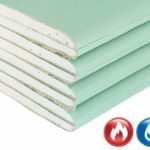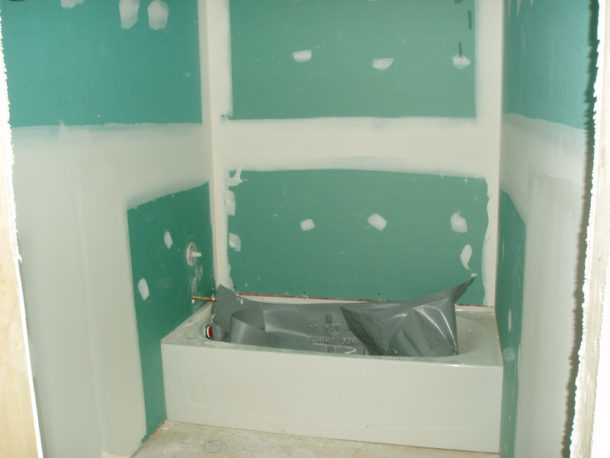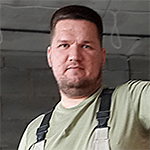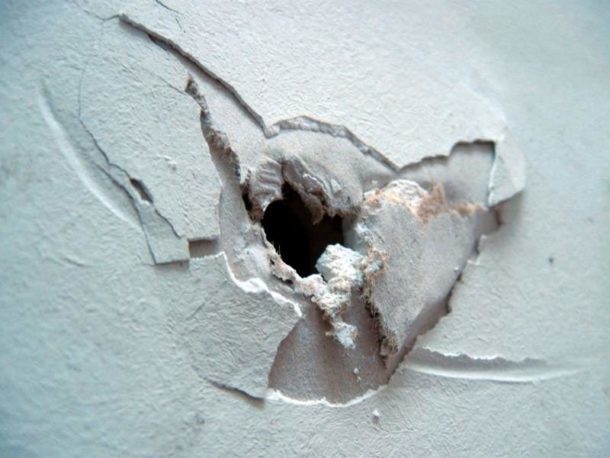Content
- Types of Drywall
- GKLV characteristics
- Sizes, types of edges
- Decoding GKLV marking
- Scope of moisture resistant drywall
- GKLV "Knauf": new designation, features, price per sheet
- GKLV “Volma” (compare with “Knauf”)
- Sealing joints of structures made of moisture-proof drywall
During the repair, more and more home masters choose “dry” technologies and replace traditional plaster and cement mortar with gypsum-based plates. Using drywall, you can easily align walls and ceilings, build suspended structures, niches and ducts, partitions and built-in wardrobes. For the decoration of rooms with high humidity, GKLV is used - a moisture-resistant type of drywall.

Types of Drywall
Since the invention of drywall in 1894, an American engineer O. Sequette material has changed significantly. Today in construction stores you can buy 4 types of sheets with different characteristics:
- Conventional drywall - GCR. They consist of a gypsum mixture enclosed between two layers of cardboard. A standard sheet of such a material has dimensions of 1200 × 2500 mm with a thickness of 9.5 mm. Suitable for repair work in living rooms. It cannot be used in the bathroom and toilet: cardboard and gypsum do not tolerate a humid environment.
- Moisture-resistant drywall, abbreviated GKLV. It is easy to distinguish it even without reading the marking: the sheets of this material are painted in light green. Hydrophobic impregnation protects cardboard and gypsum from moisture. At the same time, it increases the weight of the product.
A standard drywall sheet with a thickness of 9.5 mm weighs about 22 kg, and the same size GKLV element will “pull” 27.
- Fire-resistant drywall - GKLO. It is used for facing fireplaces and wall stoves in rooms with high air temperature, public buildings with high traffic. Its sheets turn reddish.
- GKLVO - universal sheets capable of simultaneously withstanding the effects of high temperatures and moisture. They are used in baths or saunas, in boiler rooms, when sheathing wooden houses to protect them from fire, in damp rooms with increased fire safety requirements.

- GCR ordinary

- GKLV

- Hklo

- GKLVO
When choosing the type of drywall, it is important to consider its relevance to the field of application. It makes no sense to use moisture-resistant or refractory material in ordinary rooms. Given the higher price, the investments will be unjustified: the unique qualities of the sheets will not be used. But why overpay for the properties of the material, which are not useful in a particular room?
USEFUL INFORMATION:What is an anemostat?
GKLV characteristics
Moisture-resistant drywall of high quality has the following properties:
- Resistant to moisture. It tolerates humidity indoors up to 90%.
- Antiseptic additives prevent mold from developing.
- The material is resistant to mechanical damage.
- Made from environmentally friendly components.
- It is not subject to burning, with prolonged exposure to high temperatures it is only charred.
- The amount of moisture absorbed is 1/10 of that of a conventional drywall.
The video will demonstrate how different the result is when dousing with GKL and GKLV.
Sometimes moisture-proof drywall is called water-resistant, but this is not entirely true. Still, this material is not intended for direct contact with water and requires additional protection in the form of moisture-resistant putty and a suitable finish.
GKLV is often confused with similar abbreviations GVL or GVLV. Despite the presence of gypsum in the composition, this is a completely different material - gypsum sheets ordinary and moisture resistant. The difference lies in the manufacturing technology: cellulose fibers are added to the gypsum, which after pressing create a homogeneous structure. Such sheets do not have a shell; they are more durable and heavy, and even more expensive.
Sizes, types of edges
For the convenience of consumers, sheets of various sizes are produced:
- The length ranges from 2000 mm to 4800 mm.
- Width - from 600 to 1200 mm.
- Thickness - from 6.5 to 24 mm.
GKLV differ in the shape of the edges:
- PC (SK) - direct.
- UK (AK) - thinned.
- ZK (RK) - rounded.
- PLC (HRK) - semicircular.
- PLUK (HRAK) - semicircular refined.
The shape of the edge affects the peculiarities of sealing joints between sheets.

Decoding GKLV marking
Consider an example. Suppose we have a drywall sheet with the inscription:
GKLV-A-PK-2000 × 1200 × 9.5 GOST 6266-97 DIN 1 81 80
USEFUL INFORMATION:Do-it-yourself installation of a ceiling box made of drywall
The decoding of this marking looks like this:
- Moisture-resistant drywall.
- Accuracy class A.
- Straight edges of the sheet.
- Length - 200 cm.
- Width - 120 cm.
- Thickness - 9.5 mm.
- The products have a technical certificate of conformity GOST 6266-97 DIN 1 81 80
Scope of moisture resistant drywall
GKLV has a wider scope in comparison with conventional GKL:
- The material is used for finishing work in rooms with a humidity level of more than 60%: in the kitchen, on the balcony, loggia, in the toilet and bathroom, washing facilities of baths and saunas.

- With its help, a full range of work is carried out, which is typical for ordinary drywall: they align ceilings and walls, build partitions, niches, boxes and multi-level structures.

- GKLV is indispensable in the repair of premises experiencing high operational loads: offices, warehouses, production shops. The properties of the material allow you to regularly carry out wet cleaning without risking damage to the interior finish.
GKLV "Knauf": new designation, features, price per sheet
Moisture resistant Knauf drywall now has the marking GSP-H2 (gypsum building board with additives that reduce water absorption). It is made in accordance with GOST 32614-2012 (EN 520: 2009). By default, GKLV is supplied with a refined semicircular edge (marking PLUK), which contributes to the formation of a tight joint. To order, the manufacturer makes sheets with edges of other types.

The durability of the structures under construction is ensured not only by the high quality of the material, but also by observing during installation the conditions prescribed in SNiP 23-02-2003 “Thermal protection of buildings”. Knauf gives such recommendations:
- The temperature in the repaired room should be above 10 ° C.
- Drywall sheets are aged at the installation site for at least 24 hours. This will allow them to acclimatize and not change their linear dimensions in the future.
- The edges of the ends of the GSP-H2 drywall are rectangular, therefore, for a high-quality seal of the seam after installation, they are first chamfered. Its tilt angle is approximately 45˚, and the depth is 1/3 of the sheet thickness.
The cost of GKLV from Knauf in Moscow:
- for a standard sheet 2500 × 1200 × 12.5 - from 280 to 350 r .;
- per sheet 2500 × 1200 × 9.5 - from 275 to 350 p.
USEFUL INFORMATION:PVC decorative panels: great features at the lowest cost
GKLV “Volma” (compare with “Knauf”)
Some novice masters believe that the Volma and Knauf drywall differ only in price, and the second one is higher solely because of the brand’s “untwisted” position. Indeed, GKLV Volma is cheaper:
- sheet 2500 × 1200 × 12.5 costs from 216 to 330 rubles;
- price per sheet 2500 × 1200 × 9.5 - from 210 to 325 p.

In practice, the differences are more significant. The moisture-proof Volma drywall is heavier: a 2.5 × 1.2 m sheet with a thickness of 12.5 mm weighs 37.5 kg, while the weight of a similar Knauf sheet is 25 kg. In addition, judging by the reviews from the forum, it is more solid and fragile, so it is more difficult to cut it.
-
Knauf 60%, 111 of votes
111 of votes60%
111 votes - 60% of all votes
-
Volma 13%, 24 vote
24 vote13%
24 votes - 13% of all votes
-
Giprok 12%, 22 vote
22 vote12%
22 votes - 12% of all votes
-
The one in the store 12%, 22 vote
22 vote12%
22 votes - 12% of all votes
-
"Magma" 4%, 7 of votes
7 of votes4%
7 votes - 4% of all votes
Total Votes: 186
Voted: 153
15.03.2018
×
You or from your IP have already voted.Sealing joints of structures made of moisture-proof drywall
Operation in a humid environment requires the maximum protection of drywall from moisture. The most vulnerable places are the seams between the elements, so they pay special attention to their closure.

In general, this procedure differs from the finishing of conventional GCR with only the materials used. For GKLV use fiberglass tape and waterproof putty. The latter also closes the holes formed by the heads of the screws. The durability of the structure depends on the quality of the joints.

EXPERT SITE
Tsugunov Anton Valerevich
Master Station Wagon
- Since 2003, I have been engaged in the repair and decoration of premises.
- Over 100 completed objects.
- I appreciate the quality, more than the quantity!
Personal page >>>
Friends!
I offer you the service "Friend Builder"
As this site develops, subscribers and visitors are turning to me more and more often asking for help with advice on various issues of repair and decoration.
Questions are sometimes asked very complex and interesting. You can’t write an article for each situation, so I decided to advise you individually.
Thanks to you, friends, a new direction of my favorite work has been born - share your experience and benefit everyone who is undergoing repairs!
Get a one-time consultation from me >>>
Order full apartment repair support >>>


